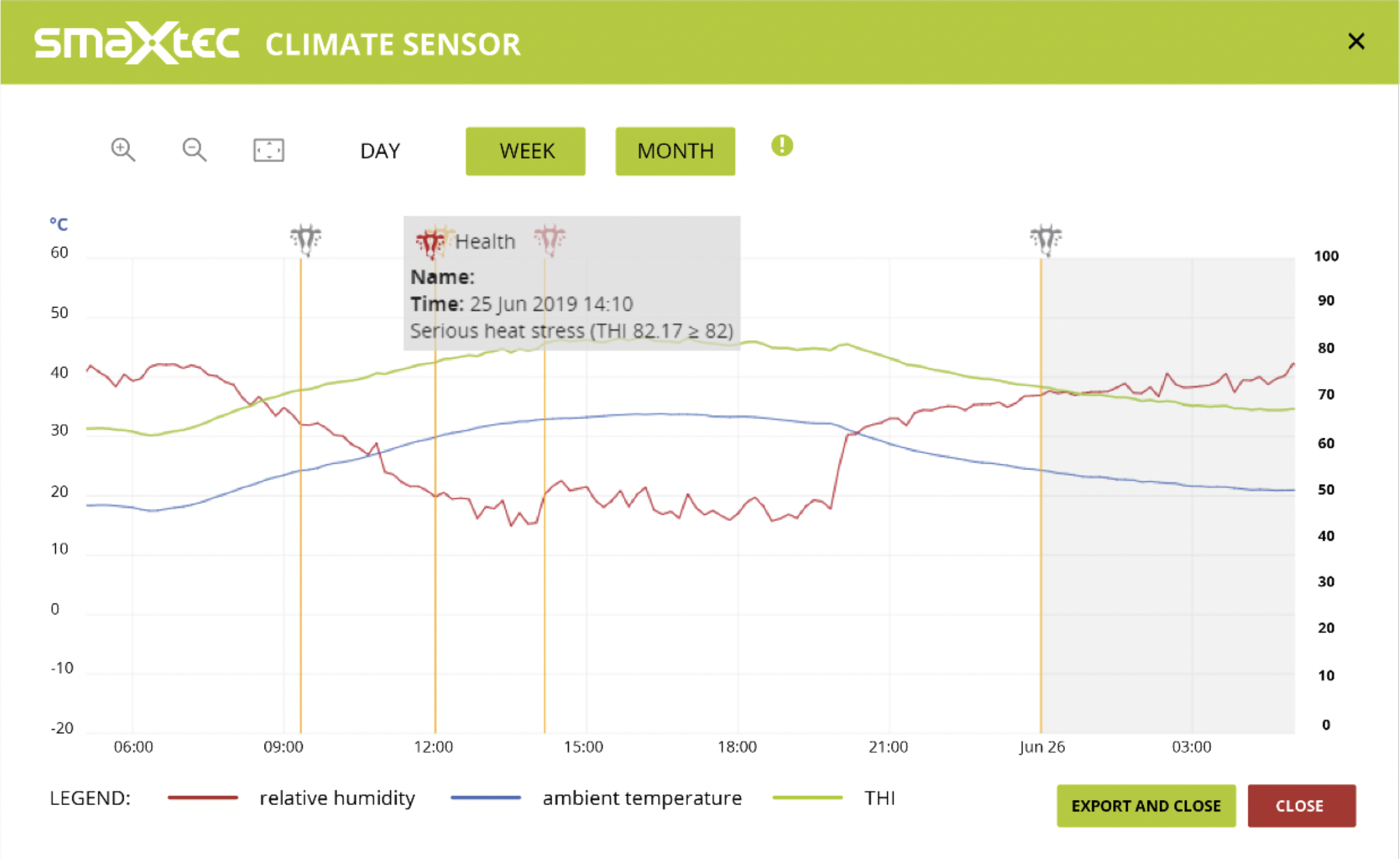Heat stress is an enormous burden for the animals, which can have dire consequences for productivity and animal health. With smaXtec, you can accurately detect heat stress and take immediate action to relieve the cows. The result: a healthier herd with stable milk yield and better fertility, resulting in less work and costs.
The hot season is imminent. Farmers should be aware that for cows temperatures of more than 16 °C are already at the edge of their comfort zone. Not least due to climate change, there are more and more intense hot days in milder latitudes, which can become a real problem for dairy farms. While for us humans a day above 30°C outside temperature is called a hot day, the critical upper limit for cattle is already reached at just over 25 °C and they start to suffer from the heat – with major consequences for health and milk yield (1).
smaXtec supports farmers in detecting and counteracting heat stress in time because the system measures both the inner body temperature of all cows and, with the Climate Sensor, also records the external climatic conditions in the barn.
smaXtec measures and detects heat stress on 3 levels:
- The smaXtec bolus continuously and precisely measures essential health parameters directly inside each cow and thus detects physiological effects of heat stress at an early stage.
- The Climate Sensor measures external factors of the barn climate that promote heat stress.
- Using the group metric temperature, the system also detects changes at group level and thus enables even more targeted intervention.
Detect heat stress with precise data from the inside
The smaXtec bolus measures the inner body temperature, drinking behaviour and quantity, rumination and activity of each individual cow. All these parameters are monitored continuously and allow for early detection of heat stress. The system reliably detects heat stress symptoms such as:
- Increased body temperature
- Low water absorption
- Reduced rumination
- Decreased activity
Keeping an eye on barn climate with the Climate Sensor
The new smaXtec Climate Sensor SX.2.1 measures outside temperature, humidity and atmospheric pressure in the barn and automatically calculates the THI (Temperature Humidity Index) from the data. The THI is an indicator of heat stress and is calculated from the factors ambient temperature and relative humidity. At values above 67, mild heat stress begins for the cows (2).
- THI ≥ 72: initial heat stress
- THI ≥ 78: significant heat exposure
- THI ≥ 82: severe heat stress
At a humidity of 70 %, which is common in temperate zone, mild heat stress for cows at an air temperature of 22 °C, and performance losses can already be expected from 24 °C (2).
If the THI is increased and there is a risk of heat stress, smaXtec sends an alert so that measures can be taken immediately to improve the barn climate.

The example shows the THI (green curve) rising over the course of a day and three heat stress alarms that smaXtec sent to the farmer: 9:00: early signs of heat stress, 12:00: increasing heat stress, 14:00: severe heat stress.
Manage animal groups individually
To make the individual temperature reports even more accurate, smaXtec also calculates the group temperature of certain animal categories. In this way, rising outdoor temperatures and temperature increases due to vaccinations or feed changes are taken into account and included in the messages. The group allocation also makes it visible if, for example, lower-ranking animals are increasingly affected by heat stress because they are perhaps prevented from drinking sufficiently by higher-ranking animals. The group metric temperature thus enables even more targeted intervention in case of heat stress.
Heat stress is not a minor matter!
If dairy cows suffer from heat stress, this not only has massive negative effects on animal welfare, but also on milk yield, fertility and animal health.
- Decrease in feed intake: increased risk of ketosis in high-performance animals (3)
- Lack of water: despite sufficient supply, cows drink too little in hot weather (3)
- Drop in milk yield by 16 - 30 % (3)
- Increased milk urea content
- Reduced milk fat content due to lower ruminating activity (5)
- Increased cell count in milk because concentrate is preferred and too little roughages are eaten (5)
- Reduced fertility: cows do not show clear signs of oestrus and pregnancy rate decreases (3)
- Increased incidence of mastitis, laminitis, and rumen acidosis with prolonged heat (3)
- Emigration of pathogenic germs from the digestive tract (E. coli)
- In the case of very severe heat stress, much more serious problems can occur, leading in the worst case to death. (1)
Only smaXtec continuously and precisely records all important internal and external factors for the detection of heat stress and thus offers all animal owners the chance to detect a heat problem at an early stage and to prevent it in a targeted manner.
Sources:
(1) STÖBER, M., 2002: Hitzschlag/exogene Hyperthermie, in: Dirksen, G., Gründer H.D und Stöber M. (Hrsg.): Innere Chirurgie und Medizin des Rindes, Parey Verlag Berlin, Wien, 1163-1165
(2) https://www.dlg.org/de/landwirtschaft/themen/technik/technik-tierhaltung/dlg-merkblatt-450
(3) https://raumberg-gumpenstein.at/jdownloads/Tagungen/Nutztierschutztagung/Nutztierschutztagung_2014/3n_2014_gasteiner.pdf
(4) https://www.journalofdairyscience.org/article/S0022-0302(19)30357-1/fulltext
(5) https://raumberg-gumpenstein.at/forschung/forschung-aktuelles/hitzestress-in-der-rinderhaltung.html